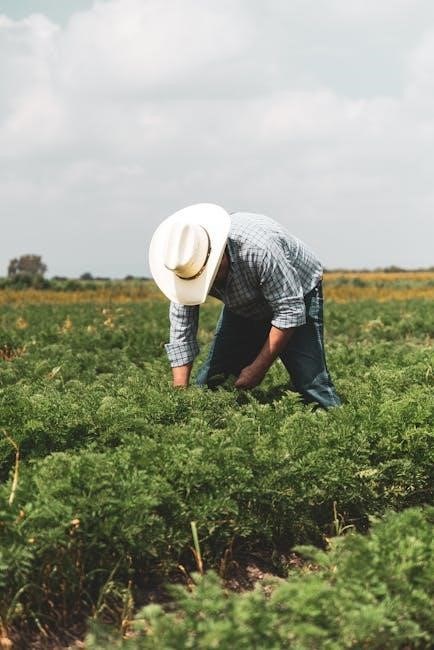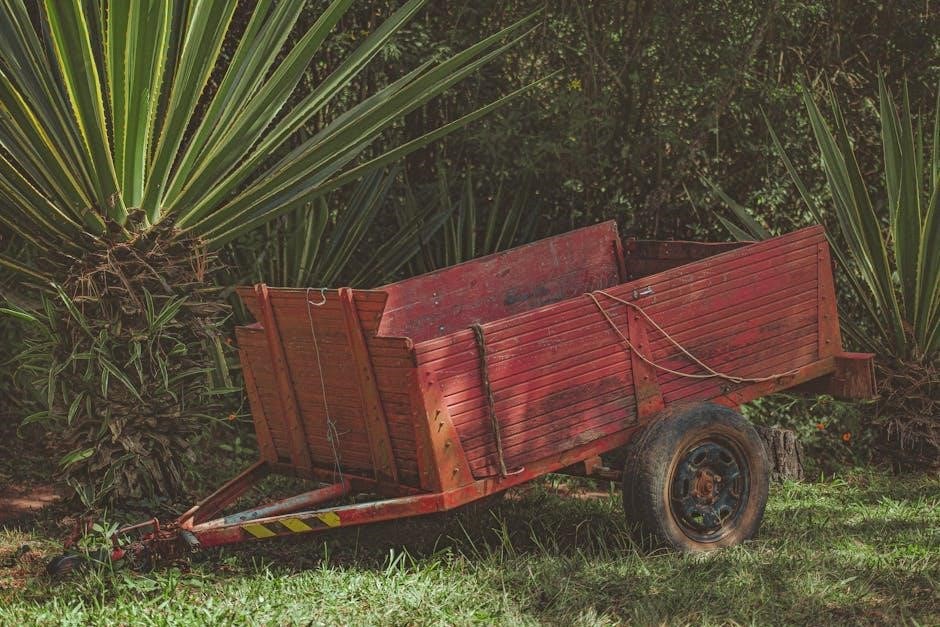Manual of woody landscape plants provides comprehensive information on over 1000 species of plants, serving as a valuable resource for landscapers and gardeners, using
identification
techniques and descriptions.
Overview of the Book
The manual of woody landscape plants is a comprehensive guide that provides detailed information on various aspects of woody plants. The book is divided into sections that cover different topics related to woody plants, including their identification, ornamental characteristics, and uses. The manual is written in a clear and concise manner, making it easy for readers to understand and navigate. The book is intended for use by landscapers, gardeners, and horticulture professionals who want to learn more about woody plants and how to care for them. The manual includes a wide range of information, from the physical description of plants to their growth habits and cultural requirements. The book is a valuable resource for anyone who wants to learn more about woody plants and how to use them in landscaping and gardening projects. The manual is a complete guide that covers all aspects of woody plants, making it a useful tool for both beginners and experienced professionals.
Importance of the Manual
The manual of woody landscape plants is a highly valued resource in the field of horticulture and landscaping. The manual plays a crucial role in providing accurate and reliable information on woody plants, which is essential for making informed decisions in landscaping and gardening projects. The manual’s importance lies in its ability to bring together a vast amount of information on woody plants, making it a one-stop reference for professionals and enthusiasts alike. The manual’s comprehensive coverage of woody plants has made it a standard reference in the industry, and its importance cannot be overstated. The manual has been widely acclaimed for its accuracy and attention to detail, and it continues to be a trusted source of information for anyone involved in the care and management of woody plants. The manual’s importance is further emphasized by its widespread adoption in educational institutions and professional organizations.

Identification of Woody Landscape Plants
Manual provides detailed descriptions and
characteristics
for accurate plant identification purposes always.
Physical Description of Plants
The manual of woody landscape plants includes a detailed physical description of each plant species, which is essential for identification and selection purposes.
This description typically includes the plant’s size, shape, and growth habit, as well as the color and texture of its leaves, flowers, and fruits.
The physical description also covers the plant’s bark, twigs, and other distinctive features that can be used to identify it.
By providing a thorough physical description of each plant species, the manual helps landscapers, gardeners, and horticulturists to make informed decisions about plant selection and placement.
The physical description is also useful for diagnosing plant problems and identifying potential pests and diseases.
Overall, the physical description of plants is a critical component of the manual, and it plays a vital role in helping users to understand and work with woody landscape plants.
The manual’s physical descriptions are based on the latest research and are written in a clear and concise manner, making them accessible to a wide range of users.
The descriptions are also accompanied by illustrations and photographs, which help to further clarify the physical characteristics of each plant species.
This information is essential for anyone working with woody landscape plants, and it is a key feature of the manual.
The physical description of plants is a valuable resource that can be used in a variety of contexts, from landscape design to plant breeding.
It is an important tool for anyone who wants to learn more about woody landscape plants and how to work with them effectively.
The manual’s physical descriptions are a testament to the importance of careful observation and documentation in the field of horticulture.
By providing a detailed and accurate physical description of each plant species, the manual helps to promote a deeper understanding and appreciation of woody landscape plants.
The physical description of plants is a critical component of the manual, and it is an essential resource for anyone working with woody landscape plants.
The manual’s physical descriptions are a valuable contribution to the field of horticulture, and they will continue to be an important resource for years to come.
The physical description of plants is a key feature of the manual, and it is an important part of what makes the manual such a valuable resource.
The manual’s physical descriptions are based on the latest research, and they are written in a clear and concise manner.
The physical description of plants is an essential tool for anyone working with woody landscape plants, and it is a critical component of the manual.
The manual’s physical descriptions are a testament to the importance of careful observation and documentation in the field of horticulture, and they will continue to be an important resource for years to come.
Elaboration of Hardiness and Growth Rate
The manual of woody landscape plants contains detailed information on the hardiness and growth rate of various plant species, which is essential for landscapers and gardeners to make informed decisions.
The hardiness of a plant refers to its ability to withstand extreme temperatures, drought, and other environmental stresses, while the growth rate determines how quickly a plant will reach its mature size.
This information is critical in selecting the right plants for a particular landscape or garden, as it affects the overall appearance and maintenance of the space.
The manual provides a comprehensive guide to the hardiness and growth rate of over 1000 species of woody plants, including trees, shrubs, and vines, allowing users to compare and contrast different species.
By understanding the hardiness and growth rate of different plants, landscapers and gardeners can create beautiful and thriving landscapes that require minimal maintenance.
The manual’s elaboration of hardiness and growth rate is a valuable resource for anyone involved in landscaping or gardening, providing the knowledge needed to make informed decisions and create stunning outdoor spaces.
With this information, users can choose the right plants for their specific climate and landscape, ensuring that their outdoor space is both beautiful and sustainable.
The manual’s detailed descriptions and comparisons of hardiness and growth rate make it an indispensable tool for professionals and amateurs alike.

Ornamental Characteristics of Woody Plants
Manual describes plants’ ornamental features, including flowers, fruits, and foliage, using
descriptive language and images.
Culture and Propagation of Woody Plants
The manual provides detailed information on the culture and propagation of woody plants, including techniques for planting, pruning, and training.
It also covers the different methods of propagation, such as seed, cuttings, and grafting, and discusses the importance of soil quality and nutrition.
In addition, the manual offers guidance on how to care for woody plants, including watering, fertilizing, and pest management, to ensure optimal growth and health.
The manual’s coverage of culture and propagation makes it a valuable resource for landscapers, gardeners, and horticultural professionals.
By following the manual’s guidelines, individuals can successfully cultivate and propagate a wide range of woody plants, from trees and shrubs to vines and groundcovers.
The manual’s information on culture and propagation is based on the latest research and best practices, making it a trusted and authoritative source in the field of horticulture.
Uses of Woody Landscape Plants
Woody plants are used for landscaping, erosion control, and wildlife habitats, providing aesthetic and functional benefits, with
various applications.
Landscape Value and Cultivars
The manual of woody landscape plants discusses the landscape value of various species, including their ornamental characteristics, growth habits, and cultural requirements.
It also explores the different cultivars available, their unique features, and how they can be used to enhance the aesthetic appeal of landscapes.
Additionally, the manual provides information on how to select and use cultivars effectively, taking into account factors such as climate, soil type, and intended use.
By understanding the landscape value and cultivars of woody plants, landscapers and gardeners can make informed decisions and create beautiful, functional, and sustainable landscapes.
The manual’s coverage of landscape value and cultivars is comprehensive and detailed, making it a valuable resource for anyone involved in landscaping or horticulture.
Overall, the manual of woody landscape plants is an essential tool for creating and maintaining stunning landscapes that thrive and evolve over time, with careful planning and attention to detail.

Author and Editions of the Manual
Dirr is the author, with multiple editions published, including updates and new information on
editions
and the author’s experiences.
New Editions and Updates
The manual has undergone several updates and new editions, with the author incorporating new information and experiences. The new editions include notes and observations from the author’s sabbatical to Hillier Arboretum in England, which holds the greatest collection of hardy woody plants in the world. Additionally, the author visited and studied woody plants at 112 gardens and nurseries, gaining valuable insights and knowledge. These updates and new editions have enhanced the manual’s value and relevance, making it an even more comprehensive and authoritative resource for landscapers and gardeners; The updates also reflect the author’s continued commitment to providing accurate and up-to-date information on woody landscape plants. With each new edition, the manual has expanded its coverage of various topics, including plant identification, culture, and propagation. The updates have also improved the manual’s organization and accessibility, making it easier for readers to find the information they need. Overall, the new editions and updates have solidified the manual’s position as a leading resource in the field of woody landscape plants.

and Recommendations
The manual of woody landscape plants is a valuable resource for anyone involved in landscaping and gardening. In conclusion, the manual provides a comprehensive guide to the identification, culture, and propagation of woody plants. The author’s expertise and experience are evident throughout the manual, making it a trusted source of information. The manual’s recommendations for the use of woody plants in landscaping are practical and informative, and the inclusion of notes and observations from the author’s sabbatical add a unique perspective. Overall, the manual is a must-have for landscapers, gardeners, and anyone interested in woody plants. The manual’s conclusions and recommendations are based on the author’s extensive research and experience, and are presented in a clear and concise manner. The manual’s value lies in its ability to provide accurate and up-to-date information, making it an essential tool for anyone working with woody landscape plants. The manual’s recommendations are practical and easy to follow, and the conclusions drawn are supported by the author’s expertise.



